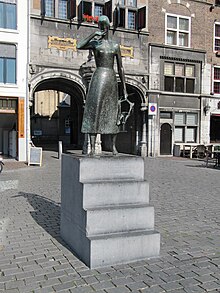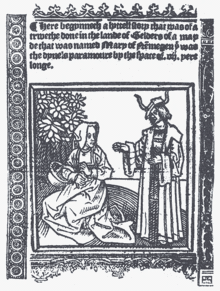Mariken van Nieumeghen
Mariken van Nieumegen (also known as Mariken van Nimwegen or Marieken van ... ) is a Dutch mystery play from the early 16th century. The author is unknown. A first print edition by Willem Vorsterman in Antwerp is documented from 1515. The original title there is Die waerachtige ende seer wonderlycke historie van Mariken van Nieumeghen die meer dan seven jaren met den Duvel woonde ende verkeerde (for example: “The true and whimsical story of Marichens from Nijmegen, who lived with the devil for over seven years and dealt with him used ”), there is a copy in the Bavarian State Library .
The mystery play is attributed to the tradition of the Rederijkers , probably from the speakers guild of Antwerp. An authorship by Anna Bijns was considered, but has not prevailed in research.
action
Mariken lives near Nijmegen with her uncle, the priest Gijsbrecht. When she travels to Merkt in Nijmegen one day, she is supposed to stay with her aunt. She is very upset because she argued with neighbors about the arrest of the Duke of Geldern , Arnold von Egmond, by his son, Adolf von Egmond . Beside herself she attacks Mariken and accuses her of having an affair with her uncle.
Mariken turns around madly from mortification and prays for help, but says that it does not matter to her whether she helps God or the devil. The devil appears to her in the form of Moenen . He offers her the knowledge of all languages and the liberal arts , with the exception of necromancy . However, she has to give up her name because of its sacred meaning, she changes it to "Emken" (ie: "small M") and the sign of the cross is forbidden. Together they travel via 's-Hertogenbosch to Antwerp , where they lead a sinful life.

After seven years, Mariken returns to Nijmegen and sees a mystery play on a moving stage ( wagenspel ), the Masscheroen play , on the market . In the storyline, God forgives a repentant sinner through the intercession of Mary . Then Mariken is overcome by repentance and she appeals to God for mercy, which makes Moenen very angry. He lifts Mariken high in the air and hurls her to the ground. But she survived the fall, because Gijsbrecht, who was present among the audience, prays for her and can drive away Moenen through quotations from the Bible.
Mariken now wants to get forgiveness for her sins and seeks with her uncle the highest priest in Nijmegen. The latter does not see herself in a position to grant her absolution , which is why she has to travel to the Archbishop in Cologne , and finally even visit the Pope . During their trip, Moenen carried out several unsuccessful attempts to kill Gijsbrecht and Mariken.
The Pope punishes Mariken for wearing three iron rings around her neck and arms, which should only fall when her sins have been forgiven. As a penance, Mariken enters a monastery, the Wittevrouwenklooster in Maastricht . After more than 23 years of penance, the Archangel Gabriel finally appears and removes the rings. Mariken now lives in peace until she dies in 1500. The rings are placed on her grave.
shape
As in Beatrijs , who came from the 14th century, it is also about seducing a young woman, but in his language and the circumstances described it is much less courtly, but oriented towards the common.
The content includes a prologue and, depending on the printed version, 12–15 scenes in paired rhymes that are linked by prose transitions.
The editor Dirk Coigneau considers that it had not acted to an imaginary piece for performance, since it is strongly oriented etc. in construction with discharges on prose novel us so as closet drama was intended.
Historical classification
By mentioning specific historical events, the piece stands out from others in its genre. The arrest of the Geldrian Duke can be dated to the year 1465. The Wittevrouwenklooster is also a historic building that was used as a monastery until the 19th century and which now houses a theater.
Since the storyline spans thirty years (seven years with the devil, 23 years of penance) and the oldest surviving print version was published 151, it is assumed that the text was not available in this form until 1480 at the earliest and that manuscripts that have not survived could not have existed until 1465 at the earliest.
origin
However, the real origin of the fable is largely unknown. In 2008, the church historian Herman Teule from Radboud University Nijmegen discovered a Syrian prose version from 1821, which was based on an Italian adaptation and had been distributed by missionaries.
Dirk Coigneau, however, put forward the thesis that the story originally came from Syria , and referred to parallels to a vita of Abraham von Kaschkar , which dates from the 6th century.
Editions and edits
The work appeared in numerous editions. As early as 1518, three years after the first edition by Willem Vorsterman, an English prose translation was published by Jan van Doesborch in Utrecht.
A Latin translation was included by Hadrianus Lyraeus in his Trisagion Marianum in 1648 and from there found its way into the Italian Sabati del Giesù di Roma by P. Joannes Rho . The version there was adopted in the Marianischer Gnaden- und Wunderschatz (Augsburg 1737) and in Glorie di Maria (Italian by Alphonsus Maria de Liguori , 1750). Luise von Ploennies made marik in Maryken von Nimegen. Poetic epic 1858 in German on a female counterpart of Faust . In 1923 the opera Mareike von Nymwegen was published by Eugen d'Albert , libretto by Herbert Alberti. Direct translations were made into German in 1918 and 1950, into English in 1924, into French in 1929, and into Norwegian. There is also a radio play adaptation in Afrikaans.
Martien Beversluis published a "lyric arrangement" in 1928; In 1935 the piece was performed with marionettes by the Dietsch student Verbond in Amsterdam. WAP Smit created an adaptation of the epic poem Masscheroen 1941 , while Hugo Claus under the title Masscheroen. Een spel in 1968 brought out a revision of the in-game game .
The story of Mariken has been filmed several times, from 1968 there is a TV film by Johan De Meester (1968); a feature film by Jos Stelling was published in 1976 and André van Duren filmed in 2000 the youth book adaptation Mariken of Peter van Gestel .
The 2015 opera Mariken in de tuin der Lusten by the Greek composer Calliope Tsoupaki is based on the mystery play.
Trivia

The city of Nijmegen honored Mariken with two sculptures: A statue by Vera van Hasselt depicting Mariken is on the Great Market. The sculpture Moenen by Piet Killaers stands at the foot of the Stevenskerk . The Nijmegen women's city marathon, the Marienloop named after her, is also a street and several public facilities.
Web links
- Marieken van Nieumeghen , digital edition of Project Laurens Jz Coster of the University of Amsterdam, edited by Joachim Verhagen.
literature
- Dirk Coigneau: Mariken van Nieumeghen . Lost, Hilversum 1996.
- GW Wolthuis: Duivelskunsten en sprookjesgestalten: studies over literatuur en folklore . C. de Boer, 1952.
- Wolfgang Achnitz (editor): Deutsches Literatur-Lexikon Das Mittelalter, Volume 4 Poetry (Minnesang - Sangspruch - Meistergesang) and Dramatics , p. 1299 ff.
Individual evidence
- ↑ Coigneau 8-9.
- ↑ Coigneau 10-11.
- ↑ Mariken was hit in Syrië . In: NRC Handelsblad , November 6, 2008. Archived from the original on August 27, 2014. Retrieved January 9, 2012.
- ↑ 'Nijmeegse Mariken is van Syrische oorsprong' . In: De Gelderlander , August 19, 2009. Retrieved January 10, 2012.
- ↑ Wolthuis 21-51.
- ↑ Coigneau 9 n.4.
- ↑ Work information on the OPERA2DAY website, accessed on May 21, 2019.
